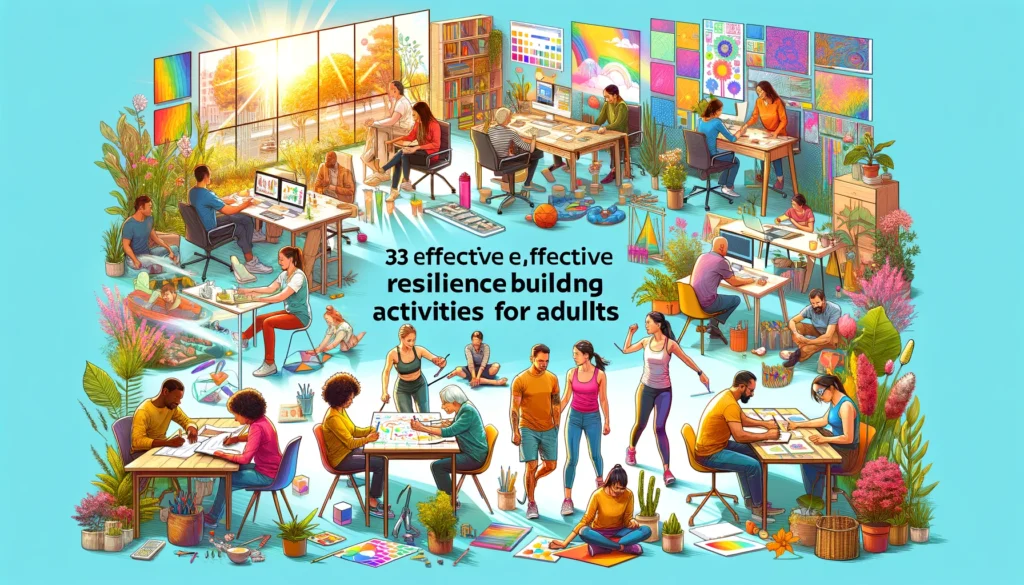Last updated on August 25th, 2025
Life is full of twists and turns, highs and lows. Sometimes, the unexpected happens, and we find ourselves needing a little extra strength to get through the day.
That’s where resilience comes into play – it’s that incredible ability to bounce back from setbacks, adapt to change, and keep moving forward no matter what life throws at us.
But how do we build this resilience? How do we strengthen our ability to handle life’s challenges with grace and courage? That’s exactly what we’re diving into today.
We’ve put together a list of 33 resilience building activities for adults. These activities are simple, practical, and aimed at boosting your inner strength and well-being.
From learning how to appreciate the little moments of joy to finding support in those around us, each activity is a step toward a more resilient you.
So, whether you’re looking to brighten your mood, improve your response to stress, or simply enjoy life a bit more, you’re in the right place.
Join us in this blog post as we explore these resilience-building practices. Let’s transform the way we face challenges, turning obstacles into opportunities for growth.
Are you ready to start your personal journey toward a stronger, more adaptable you? Let’s go right in!
What is Resilience
Resilience is like a rubber band that snaps back into shape after being stretched. It’s the ability to bounce back from tough times, challenges, or even trauma.
It isn’t about avoiding problems or feeling no pain; it’s about facing life head-on, dealing with the difficult circumstances, and coming out stronger on the other side.
Resilient people can adapt to changes, learn from their experiences, and keep going even when things get tough.
The Science of Resilience
You might wonder if some people are just born resilient. Science says it’s more complicated than that. Resilience is partly influenced by our genes, but it’s also significantly shaped by our environment and life experiences.
The brain is incredibly adaptable. Through something called “neuroplasticity,” our brains can form new connections and pathways when we learn new and different ways to cope with challenges.
That means resilience can be developed and strengthened over time, like a muscle. Scientists have found that positive relationships, a sense of purpose, and the ability to manage emotions can all contribute to a person’s resilience.
The American Psychological Association (APA) defines resilience as the process and outcome of successfully adapting to difficult or challenging life experiences.
This includes maintaining mental, emotional, and behavioral flexibility and adjusting to both external and internal demands.
The APA suggests that resilience is not a trait that people either have or do not have; rather, it involves behaviors, thoughts, and actions that can be learned and developed by anyone.
Factors contributing to resilience include having caring and supportive relationships, making realistic plans and taking steps to follow them, developing a positive view of oneself, and maintaining good communication and problem-solving skills.
Resilience and Mental Health
Resilience is a powerful ally for our mental health. When we’re resilient, we’re better equipped to handle stress, which reduces our risk of developing mental health conditions like anxiety or depression.
It’s not about never feeling down or stressed; rather, it’s about how we respond to and recover from these feelings.
Building resilience can involve learning to change negative thought patterns, developing strong social connections, and finding healthy ways to cope with stress.
Improving our resilience can lead to a more positive outlook on life, greater peace of mind, and overall better mental health.
Types of Resilience
People show resilience in various aspects of life, and it can be helpful to understand the different types to enhance our well-being and coping mechanisms.
Here are some key types of resilience:
1. Emotional Resilience: This is about managing your feelings and remaining calm under pressure.
If you’re emotionally resilient, you can handle sad or stressful situations without falling apart.
It means understanding what you’re feeling, letting yourself experience emotions without judgment, and then moving forward in a positive way.
2. Physical Resilience: This type relates to how well your body can handle physical stress and recover from illness or injury.
Building physical resilience involves taking care of your body through regular exercise, a healthy diet, enough sleep, and proper medical care when needed.
3. Mental Resilience: Mental resilience is about your mindset and thought processes. It involves staying focused, flexible, and optimistic even when faced with challenges.
If you’re mentally resilient, you can think clearly, solve problems, and find the silver lining in difficult situations.
4. Social Resilience: This type involves building strong, supportive and meaningful relationships with others.
Having a network of friends, family, and colleagues you can count on makes you more resilient to life’s ups and downs.
Social resilience means asking for help when you need it and offering support to others when they need it.
5. Community Resilience: This refers to a group or community’s ability to recover from adversity, such as natural disasters, economic downturns, or social disruptions.
Communities that are resilient can come together, support each other, and use their collective resources to overcome challenges.
6. Spiritual Resilience: This type relates to finding a sense of purpose and meaning in life, often through faith, beliefs, or values.
Spiritually resilient people often draw strength from their beliefs or sense of purpose, which helps them go through difficult times.
.
Identifying Personal Strengths
One of the first steps in building resilience skills is to identify your personal strengths. Reflect on your past successes and the skills and qualities you used to achieve them.
You can also ask friends or colleagues for feedback on your strengths.
Developing a Growth Mindset
A growth mindset means that you believe your abilities can be developed through hard work and dedication.
To develop a growth mindset, focus on learning from your mistakes and failures, instead of seeing them as a reflection of your abilities.
Accept challenges as opportunities to learn and grow, and don’t be afraid to step out of your comfort zone
33 Resilience Building Activities for Adults
Resilience is the ability to bounce back from stress, adversity, failure, challenges, or even trauma. It’s not something you’re born with; it’s built over time through practice and patience.
Here are 33 activities to help adults build their resilience in everyday life:
1. Daily Journaling
Take a little time each day for journaling. It can be morning, lunchtime, or before bed – whenever you can have a quiet moment.
Write down the events of the day, how they made you feel, and what you think you could learn from them.
This is like chatting with a friend who is always there to listen – that friend is you, on paper!
Writing helps clear your mind and makes sense of things that happen. It’s a way to pause and notice what’s going on inside you and around you.
Over time, you’ll start seeing patterns, learning about your reactions, and understanding how you’ve grown. It’s a simple tool for self-discovery and reflection.
2. Gratitude Lists
Try to imbibe a habit of recognizing the good in your life.
You can do this first thing in the morning to start your day positively, or last thing at night to end your day on a high note.
Just write down three things you are grateful for. They can be big things, like family and friends, or small joys, like a delicious cup of coffee or the sunshine.
This practice trains your brain to spot the positives in your life, shifting your mindset away from negativity and stress.
It’s a powerful way to change your outlook and bring more happiness into your daily routine.
3. Regular Exercise
Include some form of physical activity into your everyday life. It doesn’t have to be intense or time-consuming.
A quick walk around the block, a session of stretching, or dancing to your favorite music can all do the trick.
Physical activity gets your blood flowing and releases endorphins, which are chemicals in your brain that act as natural stress-relievers and mood enhancers.
Plus, moving your body regularly helps you let go of tension, boosts your energy levels, and can even help you sleep better.
Think of exercise as a daily dose of well-being for your body and mind.
4. Healthy Eating Habits
Think of eating well as filling up your car with the best possible fuel. Just as a car runs better with the right fuel, your body performs better when fed nutritious, balanced meals.
Aim to include a variety of foods in your diet – fruits, vegetables, lean proteins, whole grains, and healthy fats.
Eating well-balanced meals regularly helps stabilize your mood, energizes your body, and sharpens your mind.
It’s not just about reducing junk food; it’s about providing your body with the nutrients it needs to function at its best.
When you eat well, you’re more likely to handle stress effectively and maintain a positive outlook.
5. Adequate Sleep
Sleep is like a reset button for your brain and body.
It’s as essential as food and water. Try to get enough rest each night to allow your body to heal and recharge.
Good sleep enhances your ability to think clearly, make decisions, and stay level-headed.
It’s also vital for your physical health – helping repair your heart, muscles, and blood vessels.
If you’re well-rested, you’ll find it easier to tackle daily challenges and stay patient in difficult situations.
Establish a relaxing bedtime routine and create a comfortable sleep environment to improve the quality of your rest.
6. Mindfulness or Meditation
Set aside a few minutes each day to practice mindfulness or meditation.
This doesn’t have to be complicated. You can start by simply paying attention to your breath, noticing the air moving in and out of your body, or observing your thoughts like clouds passing in the sky, without getting caught up in them.
These practices help you stay anchored in the present moment, rather than worrying about the past or the future.
Regular mindfulness or meditation reduces stress, improves your concentration, and brings a sense of calm to your daily life.
It’s like giving your mind a break, a time to rest and rejuvenate amidst the busyness of life.
7. Positive Affirmations
Start every day with positive statements about yourself to set the tone for a confident and optimistic day.
This practice is like giving yourself a pep talk. For example, you might say “I am strong,” “I am valued,” or “I can handle whatever comes my way today.”
These affirmations help push away negative thoughts that can cloud your mind and lower your self-esteem.
Repeating these positive phrases reinforces your abilities and strengths, which can increase your overall confidence and help you face the day’s challenges more positively.
8. Problem-Solving Skills
When small issues arise, address them directly and promptly instead of avoiding them.
This could be as simple as clearing a cluttered desk, fixing a minor error in a report, or setting a weekly budget.
Successfully solving these smaller issues gives you a sense of achievement and prepares you for tackling more significant challenges.
Think of each problem as a puzzle to solve; break it down into manageable pieces, and address each one step by step.
Enhancing your problem-solving skills in this way boosts your confidence and ability to manage various situations effectively.
9. Time Management
Organizing your day can significantly reduce stress and increase productivity. Start by listing your tasks, then prioritize them based on urgency and importance.
Create a structured schedule, allocating specific times for each activity or task, and try to stick to it.
Remember to include breaks; they’re important for maintaining energy and focus.
Efficient time management isn’t just about getting more done; it’s about being smarter with your time, which gives you more control over your day and reduces feelings of being overwhelmed.
10. Strong Support Network
Build and maintain good relationships with family members, friends, and colleagues.
These connections offer invaluable emotional support systems and practical assistance.
Don’t hesitate to reach out to your network when you need advice, help, or just someone to listen. Similarly, be there for them when they need support.
A strong support network acts as a safety net when things get tough, providing comfort, guidance, and a sense of belonging.
Remember, it’s okay to ask for help, and it’s just as important to give help when you can.
11. Learning New Skills
Challenge yourself to learn something new, like a language, instrument, or craft.
This could also be anything from cooking classes to coding or even gardening.
When you learn, your brain creates new connections, which keeps it healthy and active. Starting a new hobby can be exciting and rewarding.
Each time you reach a milestone or grasp something you struggled with, your confidence grows.
You’ll prove to yourself that you can tackle new challenges and succeed, which can significantly boost your self-esteem and make life more enjoyable.
12. Setting Boundaries
Remember, it’s perfectly fine to say no to requests or invitations that don’t fit into your schedule or align with your needs.
Setting boundaries is crucial for maintaining your emotional and mental wellbeing. It means respecting your limits and ensuring others understand them too.
This might involve turning down extra work when you’re already overloaded or opting out of social events when you need time to yourself.
When you set these limits, you protect your time, energy, and personal space, leading to a more balanced and fulfilling life.
13. Breathing Exercises
Deep breathing is a simple yet powerful tool for managing stress and finding peace in tense situations.
When you feel overwhelmed, take a moment to focus solely on your breath.
Breathe in slowly through your nose, hold for a few seconds, and exhale slowly through your mouth.
Repeat this several times. This process can help slow down your heart rate and lower blood pressure, bringing a sense of calm and helping you refocus on the task at hand.
14. Laugh More
Include more laughter into your daily life.
Laughter is a natural stress reliever; it relaxes your muscles and boosts your mood.
Share a joke with a colleague, watch a funny show, or simply enjoy fun activities that make you smile.
Surrounding yourself with humor can lighten the mood, make challenges seem less daunting, and bring a positive energy to your surroundings.
Remember, it’s okay to find joy and laughter even in bad times – it’s a powerful way to lift your spirits and those of people around you.
15. Spend Time in Nature
Allocate time to step outside and immerse yourself in nature.
Whether it’s a walk in the park, a hike in the forest, or just sitting in your garden, being in nature can significantly reduce stress levels and improve your mood.
Natural settings have a way of putting things into perspective, allowing you to relax and rejuvenate.
The fresh air, the greenery, and the quiet can help clear your mind and bring a sense of peace that’s hard to find in the hustle and bustle of daily life.
16. Creative Expression
Find ways to express yourself creatively. You could paint, write stories or poetry, play an instrument, or engage in craft activities like knitting or pottery.
Creative expression is a powerful way to deal with emotions and stress.
It provides an escape, allowing you to lose yourself in the activity and express your feelings in a safe, constructive way.
Plus, seeing the results of your creativity can be incredibly satisfying and healing.
17. Volunteering
Dedicate some of your time to volunteer work.
Look for causes or organizations that resonate with your values and contribute in specific ways that utilize your strengths and skills.
Volunteering not only helps those in need but also gives you a sense of purpose and satisfaction.
Knowing you’re making a difference in someone else’s life can significantly boost your mood and self-worth.
18. Limit Social Media
Pay attention to how much time you spend on social media platforms and the impact they have on your mood.
Excessive use can lead to negative self-comparisons and a feeling of inadequacy.
Try setting specific times when you allow yourself to check social media, and stick to them.
This can help reduce the urge to constantly scroll and allow more time for activities that have a positive impact on your mental health.
19. Stress Management Techniques
Take the time to figure out what causes you stress.
Once you know your triggers, you can start learning how to deal with them effectively.
This might mean setting aside time each day for relaxation or physical activity, talking things out with friends, or practicing mindfulness or deep breathing exercises.
Managing stress is about finding what works for you and making it a part of your routine.
20. Self-Compassion
Remember to treat yourself with kindness and understanding, just as you would treat a good friend.
Be patient with yourself, recognize that everyone makes mistakes, and understand that it’s okay not to be perfect.
Practicing self-compassion can help you maintain a positive attitude and reduce feelings of stress and anxiety, especially during hard times.
21. Assertive Communication
Practice expressing your thoughts, needs, and feelings in a way that’s clear but considerate.
Being assertive means standing up for yourself while also respecting others.
This approach can lead to better relationships at home and work because it helps avoid misunderstandings and resentment.
When you communicate assertively, you’re honest about what you want or feel without being aggressive or passive.
This clear communication can prevent problems and help others understand your perspective.
22. De-clutter Your Space
Take some time to tidy up the areas where you spend a lot of time, like your home or workspace.
Getting rid of clutter can do more than just make your space look better; it can also improve your mental strength.
When your environment is organized, it can help you feel more in control and less overwhelmed.
A clean space can eliminate distractions, helping you focus better and feel less stressed.
23. Goal Setting
Set specific, achievable and realistic goals for yourself. Goals give you something to aim for and can motivate you to take action.
When setting goals, make sure they are clear and reachable.
Break larger goals into smaller, more manageable steps. Having clear goals can give you a roadmap to follow and a sense of purpose.
Each time you achieve one of your objectives, you’ll feel a sense of accomplishment and a boost in self-confidence.
24. Self-Reflection
Spend time regularly thinking about your life, your choices, and your experiences.
Reflecting on what has happened and how you’ve reacted can provide valuable insights.
It can help you understand yourself better, appreciate your strengths, and identify areas where you might want to improve.
Reflection can be done through journaling, meditation, or even quiet contemplation.
Understanding your past can inform your future, helping you make better decisions and live more authentically.
25. Acceptance
Learn to distinguish between what you can change and what you can’t. Put your energy into situations and problems that are within your control, and try to let go of the things that aren’t.
Accepting what you cannot change doesn’t mean giving up; it means recognizing the limits of your control and focusing your efforts where they can really make a difference.
This acceptance can reduce unnecessary frustration and help you find peace of mind, leading to a more content and less stressful life.
26. Flexibility
Adopt a flexible attitude towards life and work. This means being open to changes and willing to adjust your plans when necessary.
Life often throws unexpected situations our way, and being flexible allows you to handle these surprises more smoothly.
Instead of resisting change, try to go with the flow and adapt as needed. This can reduce stress and help you find solutions more easily.
27. Problem-Solving Techniques
When faced with a challenge, don’t panic or give up. Instead, break the issue down into smaller, more manageable parts. Look at each piece separately and think about possible solutions.
Tackle each part one at a time rather than trying to solve everything all at once. This step-by-step approach can make problems seem less overwhelming and easier to handle.
28. Practice Patience
Understand that growth and progress don’t happen overnight. Whether you’re working on personal goals or professional projects, be patient with the process and with yourself.
If things don’t go as planned or take longer than expected, don’t get discouraged. Remember that every step forward, no matter how small, is a step in the right direction.
Trust that with time and effort, you will get where you want to be.
29. Maintain Optimism
Try to maintain a positive outlook, even in difficult situations. Look for the silver lining in challenges and focus on what you can learn from them.
Expecting positive outcomes can actually make them more likely to happen. An optimistic attitude not only makes you feel better but can also make challenges seem more surmountable.
30. Request Feedback
Don’t be afraid to ask others for their input on your work or behavior. Constructive criticism can be a great way to learn and grow.
Make sure to ask for feedback in a way that encourages honest and helpful responses.
Listen carefully to what others say, and use their feedback to make positive changes. Remember, feedback is not a personal attack but a tool for improvement.
31. Music and Relaxation
Make a habit of listening to music that calms you down or makes you feel happy. Different types of music can influence how we feel.
Soothing tunes can help relax your mind and body, reducing stress and anxiety. On the other hand, upbeat music can energize you and lift your spirits.
Try creating playlists for different moods or situations, and notice how music affects your mood and stress levels.
Whether it’s during a break, on your commute, or while doing chores, incorporating music into your daily routine can be a simple yet effective way to enhance your well-being.
32. Personal Time
Set aside some ‘me-time’ every day for activities that bring you joy and relaxation. This personal time is vital for your mental health and well-being.
It’s not selfish; it’s necessary. Use this time to engage in hobbies, read a book, take a relaxing bath, or simply sit in silence.
These moments can help you recharge, reduce stress, and maintain a balanced lifestyle. Remember, taking care of yourself allows you to be your best for others too.
33. Celebrate Successes
Make it a point to recognize and celebrate your successes, big or small. Completing a project, reaching a personal goal, or overcoming a challenge are all achievements worth acknowledging.
Celebrating these moments can increase your sense of self-worth and motivate you to continue making progress.
You could treat yourself to something special, share the news with friends or family, or simply take a moment to reflect on your hard work and its results.
Recognizing your achievements reinforces positive behavior and reminds you of your capabilities and strengths.
Final Thoughts on 33 Resilience Building Activities for Adults
Let’s take a moment to think about what we’ve learned from the 33 resilience building activities for adults.
These are tools you can use every day to help you feel stronger, happier, and more prepared for anything that comes your way.
First off, focusing on positive things is key. Even when times are tough, there’s always something good happening that we can pay attention to.
This helps keep our spirits up and reminds us that not everything is bad.
Then there’s social support – the help and love we get from our friends and family.
This is super important because knowing we’re not alone can make the hard times a lot easier to handle.
Mental well-being is all about keeping our minds healthy.
Just like our bodies, our minds need care too. This can be anything from taking a break when we need it, to doing things we enjoy, to talking about our feelings.
We’ve also talked about resilience strategies – these are like our game plan for dealing with tough situations.
They’re the tools we keep handy to help us get through the tricky parts of life.
The resilience building blocks are the basic things we need to be strong inside. They’re the foundation for everything else, like understanding our emotions and knowing how to calm ourselves down.
Inner strength is that tough, brave part of us that helps us get through the downs of life. It’s what keeps us going even when we feel like giving up.
And let’s not forget about the good times! These are just as important as the tough ones. They’re the moments that make us smile and remind us why it’s all worth it.
So, remember, life has its ups and downs, but with these tools, you can handle whatever comes your way. Keep practicing these activities, and watch how they help you grow stronger and more resilient day by day.
For more amazing tips, subscribe at pheelpretty.com.
Love what you see? Share the love with friends and pin it to your Pinterest. Every share and pin means the world to us, helping us inspire more people. Subscribe and share now—let’s make positive changes together.










